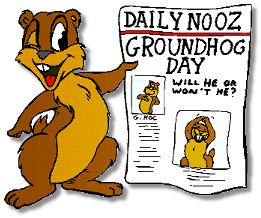
As yet another rodent takes center stage, I know you are all on pins and needles...for today's results go to:
http://www.punxsutawney.com
They'll let you know if old Phil saw his shadow. I sure hope not!
A little info on Groundhog Day history found on http://www.stormfax.com/ghogday.htm
In 1723, the Delaware Indians settled Punxsutawney, Pennsylvania as a campsite halfway between the Allegheny and the Susquehanna Rivers. The town is 90 miles northeast of Pittsburgh, at the intersection of Route 36 and Route 119. The Delawares considered groundhogs honorable ancestors. According to the original creation beliefs of the Delaware Indians, their forebears began life as animals in "Mother Earth" and emerged centuries later to hunt and live as men.
The name Punxsutawney comes from the Indian name for the location
"ponksad-uteney" which means "the town of the sandflies."
The name woodchuck comes from the Indian legend of "Wojak,
the groundhog" considered by them to be their ancestral grandfather
When German settlers arrived in the 1700s, they brought a tradition known as Candlemas Day, which has an early origin in the pagan celebration of Imbolc. It came at the mid-point between the Winter Solstice and the Spring Equinox. Superstition held that if the weather was fair, the second half of Winter would be stormy and cold. For the early Christians in Europe, it was the custom on Candlemas Day for clergy to bless candles and distribute them to the people in the dark of Winter. A lighted candle was placed in each window of the home. The day's weather continued to be important. If the sun came out February 2, halfway between Winter and Spring, it meant six more weeks of wintry weather.
The earliest American reference to Groundhog Day can be found at the Pennsylvania Dutch Folklore Center at Franklin and Marshall College:

February 4, 1841 - from Morgantown, Berks County (Pennsylvania) storekeeper James Morris' diary..."Last Tuesday, the 2nd, was Candlemas day, the day on which, according to the Germans, the Groundhog peeps out of his winter quarters and if he sees his shadow he pops back for another six weeks nap, but if the day be cloudy he remains out, as the weather is to be moderate."
According to the old English saying:

If Candlemas be fair and bright,
Winter has another flight.
If Candlemas brings clouds and rain,
Winter will not come again.
From Scotland:
If Candlemas Day is bright and clear,
There'll be two winters in the year.
From Germany:
For as the sun shines on Candlemas Day,
So far will the snow swirl until May.
For as the snow blows on Candlemas Day,
So far will the sun shine before May.
And from America:
If the sun shines on Groundhog Day;
Half the fuel and half the hay.
If the sun made an appearance on Candlemas Day, an animal would cast a shadow, thus predicting six more weeks of Winter. Germans watched a badger for the shadow. In Pennsylvania, the groundhog, upon waking from mid-Winter hibernation, was selected as the replacement.
Pennsylvania's official celebration of Groundhog Day began on February 2nd, 1886 with a proclamation in The Punxsutawney Spirit by the newspaper's editor, Clymer Freas: "Today is groundhog day and up to the time of going to press the beast has not seen its shadow." The groundhog was given the name "Punxsutawney Phil, Seer of Seers, Sage of Sages, Prognosticator of Prognosticators, and Weather Prophet Extraordinary'' and his hometown thus called the "Weather Capital of the World.'' His debut performance: no shadow - early Spring.
The legendary first trip to Gobbler's Knob was made the following year.

I can't get away from these RODENTS!!!!
Have a great Groundhog Day!
Love,
Suz




No comments:
Post a Comment